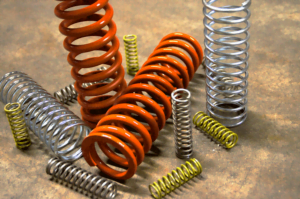Customers often think the best way to ensure their custom spring functions as intended in an application is to carefully define the spring’s physical dimensions such as free length or number of coils.
While that information is important, there is a tried and true way of simulating a spring’s function in its end-use environment: a method known as load testing. As your custom spring manufacturer, Gifford Spring Company can perform load testing here in our facility.
What Is Load Testing?
If you have heard the term load testing but are unsure what it entails, here is a quick refresher.

Load testing measures the force required to compress a spring to a specific length. For example, if a customer needs a 1” long spring to give 10 lbs of force when compressed at 0.5”, we can simulate their criteria to see how the spring will behave. Customers can also ask us to test spring rate, which is the ratio of pounds per inch of compression.
Load testing is carried out with a calibrated piece of equipment called a load tester that measures within a specific range of force. We primarily perform load testing on compression springs, though it’s possible (but more challenging and expensive) to carry these tests out on extension springs and torsion springs as well.
What Is the Purpose of Load Testing?
Load testing helps to ensure that custom springs give the force required in their end-use application. Typically, customers know how far the spring will compress and the force their spring must give at that length. Load testing can confirm success or failure in a specific tolerance range for a given load.
For example, suppose a valve application has a compression spring that needs 1 lb of force to hold the valve open or closed. Too much or too little force will cause the valve to open or close when it isn’t supposed to, resulting in failure in the end use environment. The load test helps identify the risk of spring failure, which may lead to design iterations that help the spring perform more successfully.
The industry tolerance standard for load testing is +/- 10%, meaning a 1 lb load could be between 0.9 and 1.1 lbs. Customers may require a tighter tolerance, like +/- 5%, for their load testing, although there will be an impact on setup times and costs.
Once we have carried out a load test, we include that information on our part documentation. If you require first article inspection (FAI) documentation with confirmation of the load test, we can also provide that.
What Do We Need from You?
We can fully coordinate and perform load testing for your application, but we need a few key pieces of information:
- Load height / Compressed length. The length of a spring once a specific force has been applied. You can also provide the amount of deflection from the unloaded position.
- Load / Force. The amount of force needed to compress a spring at a specified distance.
- Spring dimensions. Indicating which dimensions are flexible allows us to make the proper adjustments to achieve the desired spring rate or load.
A quick note on spring dimensions: Designs must have some flexibility in the dimensions so a spring can achieve the load height required. We often have to adjust dimensions like the number of coils or the free length of the spring to meet load goals, so knowing where we can make those adjustments beforehand is important.
If you’re looking for a custom compression spring manufacturer who can produce your spring and perform the proper testing, request a quote from Gifford Spring Company today!